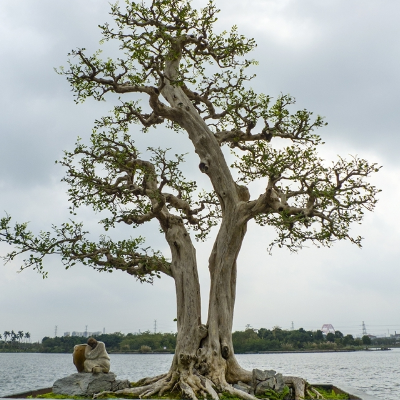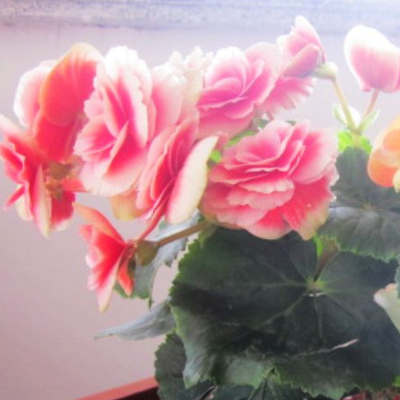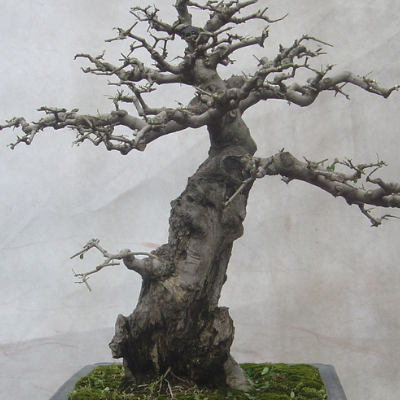What is the price of Lingnan bonsai?
Lingnan bonsai, which is a bonsai association that specializes in bonsai, is liked by many people. What is the method of making Lingnan bonsai? What is the price of Lingnan bonsai:

The production method of Lingnan bonsai:
The main results are as follows: (1) to identify the advantages and disadvantages of the tree shape: the shape of the tree is natural and shrinks slowly from bottom to top, and the shape of the base, root and trunk should be matched properly. Most avoid the expansion in the middle and lose the natural proportion. If the roots are exposed on three or four sides and grow on the outside of the soil, the size should be about 1cm.
(2) artistic conception: the key to shaping the whole bonsai should be processed according to its natural form, and strive for simplicity that cannot be forcibly changed. First conceive or draw a sketch according to the shape of the tree and then cut it to maintain the style and unique beauty of the tree.
(3) pole selection: the thickness of the stem is high and low, and the couple is in line with the proportion of the whole bonsai, so as to be harmonious and natural. Classical scars can be cut through the bark of a smooth trunk; about an inch of pruning should be left to form claws more quickly.
(4) whole root: the original fibrous root should be retained and the thick root should be cut short. If the original plate is installed, the coarse root should be truncated accordingly; if it is a square plate, the coarse root can be slightly extended to the left and right to expose the soil, forming a sense of vitality.
(5) pruning: branches located at 1/3 of the trunk must be carefully cut, dense, thick, long and short, and the distance between branches must be symmetrical. If the branches do not meet this requirement, you can cut off all the remaining trunks and let them germinate and grow again.
(6) cultivation: the pruned and shaped stump of a new tree must be cultivated before it germinates and do a good job of promoting root, shortening the time for the stump to leave the soil, sealing, transporting water, fertilizing and so on.
Price of Lingnan bonsai:
(1) Lingnan send sparrow plum boutique pile view large living room courtyard green plant pot, reference price: 48000 yuan / pot.
(2) leaflet red sandalwood pile bonsai Lingnan pie, reference price: 488 yuan / pot.
(3) Lingnan School of bonsai, valuable trees, reference price: 1088 yuan / pot.
Lingnan bonsai production methods and prices are introduced here, this is a long experience!
On the Innovation of Lingnan Bonsai
Lingnan bonsai after nearly a hundred years, through the efforts of several generations of Lingnan bonsai artists, from embryonic to gradually mature, and finally set up a school of its own. Today, Lingnan bonsai has been recognized by the world, and its influence at home and abroad is growing. It has become the most dynamic, distinctive, potential and influential bonsai in the domestic bonsai world. Many foreign bonsai people have higher and higher evaluation of Lingnan bonsai.
▲ Yu Jingtu's work "all Birds return to the Nest" (Finch Plum, 120x70 × 80cm)
▲ Yu Jing Picture (Black Pine)
Lingnan is located in the subtropics, with high temperature, high humidity, abundant sunshine and abundant rainfall, which is suitable for all kinds of plants. Especially shrub trees can grow all the year round. For example, Luo Hansong, Jiuli Xiang, Fujian tea, sparrow plum, elm, kapok, banyan, mountain orange, Acacia, crape myrtle, five-leaf maple, triangular plum, red oak, red bull, yellow poplar, Masson pine, mountain pine, black pine, water pine, water horizontal branch, red fruit, tang pear, black bone incense, Bolan, Xiangnan, red poplar, spring flower, mountain wood, crab claw incense, full sky star, pomegranate, pepper wood, bird not night, two-sided needle and so on. These are good materials for Lingnan bonsai.
▲ Yu Jing Picture (Elm)
Works by ▲ Yu Jingtu (Fujian Tea, High 70cm)
Therefore, Lingnan bonsai is dominated by miscellaneous wood, supplemented by pine and cypress. The annual growth period of miscellaneous wood bonsai is long, and there is basically no hibernating period. although a small part of them have a receding period, the time is short, only about a month, so it is very suitable for the production method of Lingnan bonsai branch storage, strip and brocade. Pine and cypress grow slowly, especially cypress trees, whose branches are soft, not easy to produce cross-horn branches, and grow very slowly, so they are not suitable for making Lingnan bonsai.
▲ Yu Jingtu's works (Park Shu)
The biggest difference between Lingnan bonsai and domestic brother schools and foreign bonsai is that Lingnan bonsai artists make Lingnan bonsai according to the principle of Chinese painting. First of all, they make up their mind according to the hidden and exposed roots of the stump, the direction of the roots, and the shape of the trunk-what kind of bonsai will it be created in the future? Lingnan bonsai, like Chinese painting, pays attention to artistic conception. The author applies his creative ideas and emotional expression to the whole process of creating bonsai. In the process of creation, according to the trend and shape of roots, heads and tree trunks, the layout of brackets and branches and the position of the top are selected to deal with the relationship between care and hope, gathering and dispersing, receiving and releasing. After dealing with these relationships, a Lingnan bonsai has stomata (traditional Chinese painting is called blank), with distinct levels, strong three-dimensional sense, emotion in the scene, and attracting people's imagination. This is silent poetry and three-dimensional painting.
▲ Yu Jingtu's works (Finch Plum)
As Lingnan bonsai is created in accordance with the principle of traditional Chinese painting, it is very strict in the production process, one more stroke (one branch support), one less stroke will affect the effect of the whole bonsai.
Works by ▲ Yu Jingtu (Ziwei)
The main method of making Lingnan bonsai is to store branches and cut dry. If it is not cut dry, it is a big tree and cannot be made into bonsai ranging from tens of centimeters to more than one meter. Of course, branching and truncation is not limited to Lingnan bonsai, other schools and foreign bonsai production also use this method. However, the branch truncation of Lingnan bonsai is different from other schools in that it shrinks the supporting branches and distributed branches into inches. In the past, the old artists said that they cut three knives per inch. Due to the use of the production method of storing branches and shrinking the size of the dragon, it is produced according to the painting theory, from the selection of the bracket to the distribution of the branches and the layout of the whole bonsai.
▲ Yu Jingtu's work "readily available" (Finch Plum, Piaochang 70cm)
Cutting is to control the proportion of branches, from thick to thin paragraph by paragraph, like a painting, a piece is a stroke. The shrinking dragon is to manipulate the direction of the branches, leading the branches to a reasonable position according to the layout. Cheng-cun is short-speed and powerful, which makes the branch receptacle appear vigorous and powerful, revealing the support position and the trend of the branches, making it clear in layers. Lingnan bonsai shows more than it hides, so it takes time and great skill to create a mature Lingnan bonsai.
As Lingnan bonsai benefits from the unique climatic conditions of Lingnan region, and is created in accordance with the principle of traditional Chinese painting, using the production method of storing branches and truncating, shrinking and shrinking into inches, Lingnan bonsai can come from nature, but higher than nature. After the long-term unremitting efforts of bonsai artists, bonsai is created in a variety of forms.
From the early near-tree shape, the single form of dwarf trees, to the continuous creation of cliff type, water-facing type, oblique floating type, moon type, kapok type, cloud head and rain foot, and so on. From single plant to multi-stem and even forest type. Especially in the past two or three decades, he has created excellent bonsai with Lingnan characteristics, such as high falling branch, big stall branch, turning back branch and so on. Because these big branches do not grow at the top, not upward, but downward or horizontally, it is particularly difficult to cultivate. It grows slowly, but also has a certain roughness and change, so it takes a long time to cultivate. In cold areas, where the annual growth period of plants is short, it is very difficult to create bonsai with big falling branches, big floating branches and big spreading branches, and it is only in the south subtropics of the range that it is easy to cultivate and create such bonsai.
Stripping and changing brocade is another way to make Lingnan bonsai. Acacia, sparrow plum, Fujian tea, Jiuli incense and other tree species can be made two or three times a year, picking all the leaves, altering and cutting the branches. This method of stripping and changing brocade is to better store branches, sprout more buds to grow twigs, speed up the maturity of bonsai, and shorten its cultivation time. After undressing and changing brocade, the bonsai has changed. Although it is carried out in spring, summer and autumn, it makes people feel that there are no leaves on the plants after snow in winter, just like the winter scenery. And more importantly, because there are no leaves, only branches, each branch is like every stroke in the painting, a little messy, can see clearly, it is simply a meticulous painting.
Internationally, there are certain restrictions on the height of bonsai, which is less than one meter. However, people in Lingnan dare to innovate and keep pace with the times. with the improvement of people's living standards and changes in the home environment, more and more people live leniently and have gardens. Small bonsai can no longer meet the needs of their spacious environment, so in the past decade, Lingnan bonsai artists have begun to create large-scale bonsai. In Guangdong and other places, people have created many large-scale Lingnan bonsai of more than 1.5 meters. These large bonsai enter the villa area, the big garden, is very favored, and sells the price is high, the economic benefit is good. More and more people like large bonsai. Large bonsai is an important aspect of the future development of Lingnan bonsai.
How does Fujian tea bonsai shape? how much is the price?
Fujian tea bonsai, this kind of bonsai is a lot of people like farming, this Fujian tea bonsai to grow into a fixed appearance is the need to shape, Fujian tea bonsai how to shape? What is the price of Fujian tea bonsai:
How to shape Fujian tea bonsai:
Fujian tea is very strong in growth and resistant to pruning, so it is suitable to use the method of "storing branches and cutting dry" adopted by Lingnan bonsai, so that the branches can achieve the effect of natural twists and turns and vigorous power by pruning many times. Common tree shapes are straight dry type, double dry type, oblique dry type, multi-dry type, jungle type, cliff type, stone-attached type and so on.
Fujian tea is an evergreen shrub with dense branches, including big leaves, middle leaves and leaflets. Among them, Fujian tea with lobular leaves has slow growth, small leaves, dark green, bright and lovely, well-developed roots, intertwined roots, quaint posture and lovable.
Fujian tea has strong sprouting ability and resistance to pruning, so it is often made into natural tree-shaped bonsai by the method of "storing branches and cutting dry". That is, the young trees used for bonsai grow to a certain thickness, carry out intensity cutting (cutting off most of the trunk), and retain 1 ~ 2 or 3 ~ 5 branches as first-class lateral branches at appropriate parts and angles. when the upper second-grade branches grow to a certain thickness, retain one or two branches and cut short to promote the growth of the third-grade branches; in turn, year after year, cut off and accumulate branches.
When the branches and leaves are too dense, in addition to cutting off the overgrown branches at any time, they will be pruned once a year in early summer and Mid-Autumn Festival. Pruning should also be carried out according to the method of "storing branches and cutting dry". After a few years of pruning, it will be cultivated into bonsai with vigorous and clumsy trunk, whirling branches and leaves, and beautiful tree shape.
Price of Fujian tea bonsai:
If you don't want to make Fujian tea bonsai yourself, you can also choose to buy it. Fujian tea bonsai is not expensive, tens to hundreds of yuan per plant. Let's take a look at some examples to learn about it.
(1) the height of Fujian tea in Wanglin horticulture is between 15cm-20cm and the reference price is 32 yuan.
(2) Jingruxuan 6 years Fujian tea bonsai, the height is between 40cm-50cm, the reference price is 129yuan.
(3) Flower Friends Home Fujian tea bonsai + rockery, the height is between 20cm-25cm, the reference price is 88 yuan.
Fujian tea bonsai prices are different, according to their own preferences to choose the height of the size.
This is the end of the modeling method and price of Fujian tea bonsai. Hurry up and have one in your own home.
- Prev

How to grow glass crabapple? can the flowers bloom and become poisonous?
Glass crabapple, this is a kind of plant, the flower is as good-looking as begonia, how can glass crabapple keep blooming? Is glass begonia poisonous: how can glass crabapple blossom continuously: (1) temperature and light glass begonia is a kind of sun-loving plant, so it should be placed in a place with sufficient light.
- Next

How much is the price of the production method of white wax bonsai
For section white wax bonsai, this bonsai is super expensive, is made of rare tree species, for section white wax bonsai how to make? How much is the price of the section white wax bonsai: the section white wax bonsai production: (1) to determine whether the selected section white wax pile head after transplantation can survive
Related
- Fuxing push coffee new agricultural production and marketing class: lack of small-scale processing plants
- Jujube rice field leisure farm deep ploughing Yilan for five years to create a space for organic food and play
- Nongyu Farm-A trial of organic papaya for brave women with advanced technology
- Four points for attention in the prevention and control of diseases and insect pests of edible fungi
- How to add nutrient solution to Edible Fungi
- Is there any good way to control edible fungus mites?
- Open Inoculation Technology of Edible Fungi
- Is there any clever way to use fertilizer for edible fungus in winter?
- What agents are used to kill the pathogens of edible fungi in the mushroom shed?
- Rapid drying of Edible Fungi

